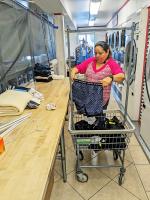GLENDALE, Ariz. — If you want to maximize your laundromat’s income, drop-off wash-dry-fold (WDF) service, pickup and delivery (PUD), and commercial work (smoke removal, restaurant linens, hair salon towels, etc.) are the popular income streams many owners use.
You can pull in thousands of pounds a week, but how do you manage your space and not interfere with your bread-and-butter self-service customers? How do you not compete with them for machines, folding tables and carts?
Some mats I’ve seen have no choice but to do PUD or commercial work due to heavy competition for self-service. There simply aren’t enough self-service customers to support their mat.
If your self-service volume is hopelessly slow after you’ve tried boosting it by installing new equipment, cleaning up your mat’s appearance, and securing adequate customer parking, you’re left with doing some kind of service work. The good part is that you don’t have many customers to bump carts with, so to speak.
Alternately, if your store is typically full of customers, doing service work there can be more daunting. When customers routinely see most of the machines occupied with other service work, they will go somewhere else. Your crew will have to wait to use some machines that are occupied by customers, but time is money. If they have work that must get out quickly, they will be forced to use the wrong machines for the job. So what can be done to lessen that impact?
I have a couple solutions to share. Mostly common-sense things that you may have thought of already. Some have been hinted at in previous columns. Not all of these solutions are palatable, so you need to figure out how much sacrifice you’ll need to make in the name of gaining more income.
AUTHOR’S FAVORITE SOLUTIONS
Use a Graveyard Crew — This is the best solution. You also get the best bang for the buck as far as maximizing your occupancy costs. (Why pay the rent with only daytime business?)
Some mats close their doors to the public after a certain hour and simply have a crew overnight to process laundry. It’s the easiest, most efficient way for your staff to get the work done.
Since I was located in New York City—“The City That Never Sleeps”—I chose to allow self-service customers in on a 24/7 basis. The overnight hours were much slower though, allowing us to get a lot of work out smoothly. For security reasons, we would lock the doors from midnight to 6 a.m. but customers could use the store if they showed their laundry. We simply buzzed them in, and the door locked behind them. The quietest time was 1 to 5.
I wasn’t comfortable leaving just one employee in the mat overnight. If your service work is plentiful enough, you can afford to staff two or more crew members during this shift, despite the fact that you may have to pay higher night rates. Keep your mat well-lit, and your windows clean and unobstructed; use a “buzz-in” system plus silent alarm buttons; and install a high-quality surveillance system.
Schedule the Work to Your Benefit — Write up your service work so you have time to spare. I believe this is the next best solution to keeping a night crew.
With drop-offs, it seems some customers have to have it back right away, yet they often don’t show up for a week after the date they had to have it! Very frustrating when you don’t have the room or time.
So, train your customers. Many of them are flexible, but you have to know how to write up their ticket.
If you ask, “So when do you want your laundry back?”, many customers will instinctively say that night or the next day, which puts pressure on the system. I overheard more than one employee promise to have the laundry ready later that day or that evening, trying to impress the customer in hopes they’d receive a tip.
If you spoil every customer into expecting their laundry back right away, you won’t have any wiggle room for the real emergency customers. You’ll have to bring in more help to get the work out in a rush, and the store will get needlessly jammed up, aggravating your self-service customers.
What’s worse, if you get customers used to expecting quick service, they’ll start showing up at the last minute to drop off. If we were jammed up and couldn’t do it for them, they freaked out.
So, I told my crew to ask a customer who was dropping off on a Monday if a Wednesday or Thursday return would be OK. Half the time, they said it was fine. Then, there was no rush, and we had room for the real rush jobs.
In Part 2 coming Tuesday: Storage issues and options
Have a question or comment? E-mail our editor Bruce Beggs at [email protected].


































